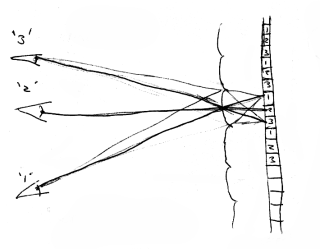Introduction
If you keep up a bit with the latest display technology, the various 3d-monitors must have caught your eye. They allow you and others sitting near you to experience a 3d-image without glasses or anything. While these monitors are nice, the price is a tad prohibitive if you just want to look at 3d-stuff now and then. Luckily, it's possible to create a ghetto version for a monitor (e.g. the one you're looking at right now), a printer and a few bucks of material.

3d-monitors nowadays usually consist of a standard TFT-panel, with so-called 'lenticular lenses' (which, by the way, is a silly name, because it basically means 'lens-shaped lenses') to make sure every eye sees a different image. The idea is that when you look at the display at a certain angle, you only see a small subset of the pixels on the screen. Change the angle you look at the screen and all of a sudden you look at a different subset of pixels. Then, you'll only need to make sure every subset displays a picture of an object as viewed from the corresponding angle and you're set. The quick back-of-an-envelope-sketch on the right hopefully illustrates the point.
One nice thing about these lenticular lenses is that they are multi-user and work even when you move your head from the left to the right: the more pixels are underneath a lens, the more angles displaying unique views you can have. With the right choice of distance between the lenses and the screen, they are stereoscopic too: when your left and right eye percieve a different image and the images at these angles correspond to a real object when viewed from these angles, the brain is 'tricked' into seeing depth.
The problem with this approach is that, while sheets of these lenses in theory can be bought, I couldn't find a source for it. Even if I could, I would need one which was made exactly to the specs of my monitor. In practice, I didn't even bother to look very far: the chances of such a sheet being both obtainable and cheap were zero to none.
1 Next »